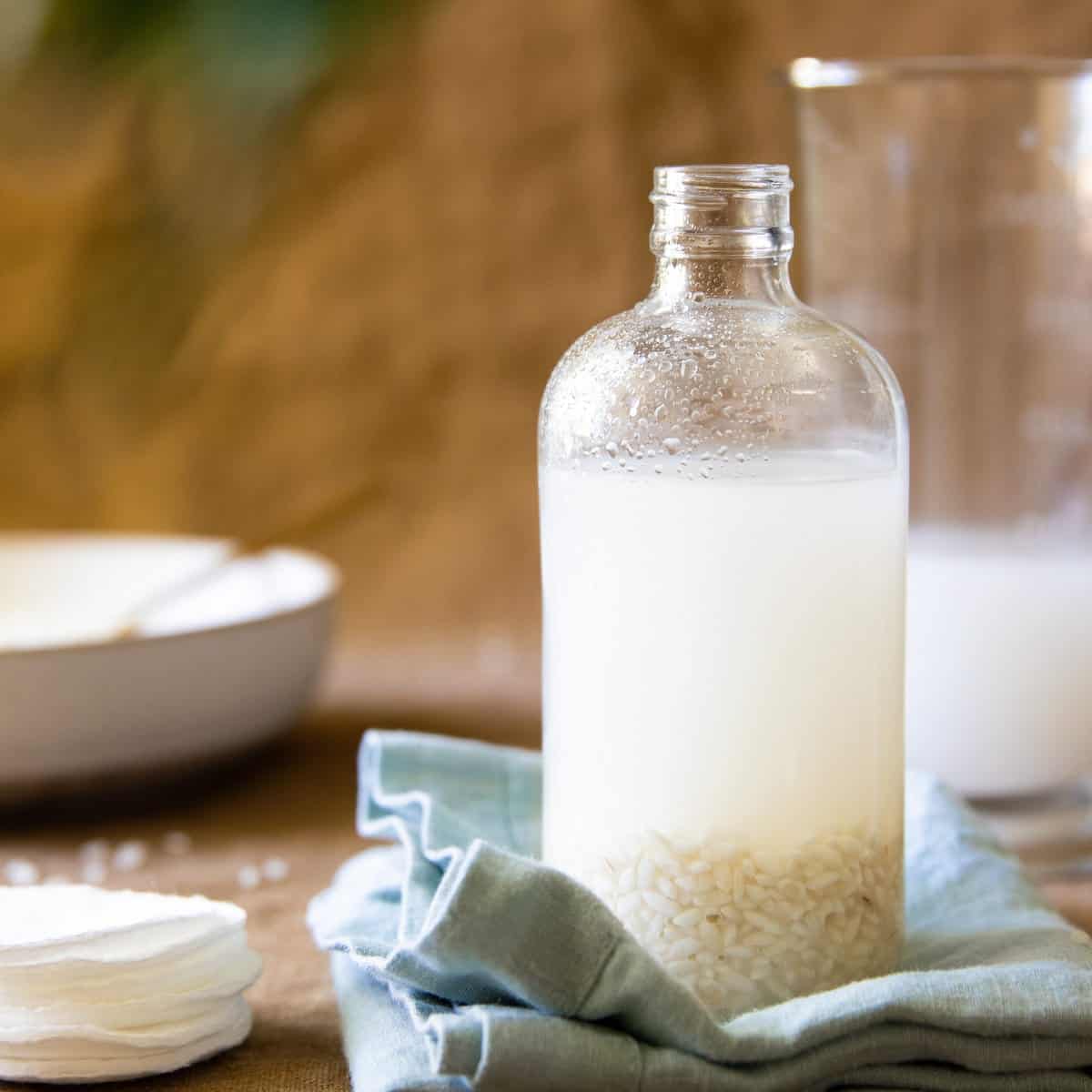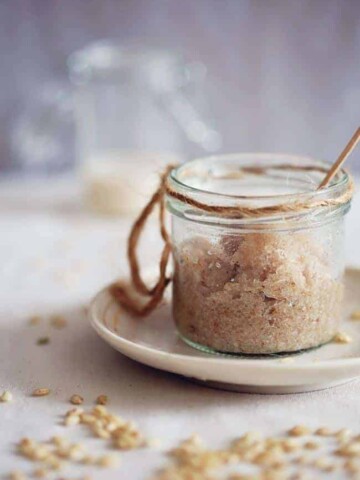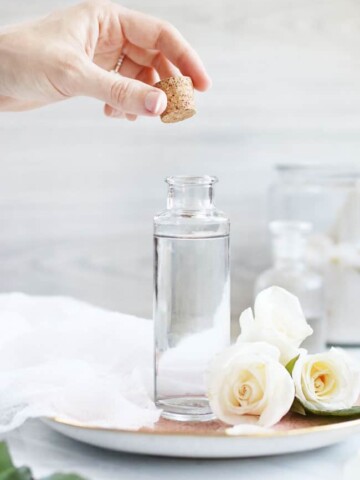Imagine a skincare product that can hydrate, soothe, brighten, and improve the overall texture of your skin—all in one bottle. Well that's exactly what this rice water toner does. When combined with the skincare powerhouses niacinamide and glycerin, this simple toner becomes a luxurious, rejuvenating potion that can nourish your complexion and soothe your skin.

In homemade beauty recipes, sometimes the most transformative elixirs come from humble origins. Case in point: rice water. Made by soaking rice in water and then straining out the rice, the nutrient-rich water that's leftover has beauty-boosting properties for your hair and skin.
And one of the easiest ways to incorporate this ingredient is in a homemade toner recipe that helps even out your complexion and lighten age spots.
Jump to:
Ingredients

Rice Water — Rice water is the liquid that remains after soaking or boiling rice. Loaded with vitamins, minerals, and amino acids, rice water has been used in skincare for centuries, especially in Asian beauty traditions. While studies are lacking, it's said to hydrate and soothe the skin, reduce redness and inflammation, and leave you with a radiant complexion.
Niacinamide — Niacinamide is a form of vitamin B3, which, when used in skincare products like toners, can help improve the skin's elasticity, reduce redness and inflammation, and help decrease acne. It is also known for its ability to reduce fine lines and wrinkles and fade hyperpigmentation [source].
Glycerin — Glycerin is a humectant, which means it attracts moisture from the environment and helps retain it on the skin's surface. It provides instant and long-lasting moisture, so skin feels softer and smoother. Plus, it helps to create a protective barrier on the skin, preventing moisture loss and protecting the skin from environmental stressors.
See recipe card for quantities.
Instructions
There are many different ways to make rice water. The easiest way, and the one that we use here, is to simply soak rice in water for 30 minutes to an hour. If you're in a hurry you can also boil it on the stove, strain out the rice and set the water aside to cool completely.
The leftover liquid is what makes the base of this hydrating facial toner.

Place rinsed rice in a clean bowl and add water. Allow the rice to soak for at least 30 minutes, stirring occasionally. During this time, the water will absorb some of the rice's nutrients and become cloudy. That's what you want!

After half an hour, strain the rice water into a separate container, discarding the rice itself (or saving it to cook and eat later, if you like). The strained liquid is your rice water.

Add niacinamide and glycerin to the mixture. Stir well to ensure that they're evenly distributed throughout the rice water.

Transfer the prepared rice water toner to a clean, empty bottle or container. A small spray bottle works well for easy application. Or a lidded bottle will work if you plan to apply the toner using a cotton round.
Recipe Variations

Skincare isn't one-size-fits-all. While niacinamide and glycerin are safe for all skin types, you may want to add ingredients that tackle your skin's specific bugaboos. You can use the following ingredients either in addition to, or in place of, the niacinamide and glycerin in your rice toner.
Hyaluronic Acid: Hyaluronic acid is a powerful humectant that can hold a significant amount of water, making it highly effective at hydrating the skin. It helps to plump and moisturize skin, reducing the appearance of fine lines and giving your skin a smoother, more youthful appearance [source].
Aloe Vera Gel or Juice: Aloe vera is known for its soothing and calming properties. It can help alleviate redness, irritation, and inflammation, making it an excellent addition to homemade toner, especially if you have sensitive or irritated skin [source].
Vitamin C: Vitamin C, also known as L-Ascorbic Acid, is a potent antioxidant that can brighten the skin, fade dark spots, and even out skin tone. It also helps protect the skin from UV damage and stimulates collagen production, promoting a youthful complexion. Just make sure to go easy on it, since it may make skin more sensitive to sunlight [source].
Green Tea: Rich in antioxidants, particularly catechins, green tea can help protect the skin from damage caused by free radicals. It may also have anti-inflammatory properties and can be soothing for sensitive skin [source].
Lavender or Chamomile Essential Oil: These essential oils not only add a pleasant fragrance but also offer calming and soothing properties for the skin. However, use them sparingly, as essential oils can be potent and may cause sensitivities in some people.
Storage
Store your homemade toner in a dry, sterilized bottle with a tight fitting lid to prevent air from getting inside. And when not in use, keep the bottle in the refrigerator to slow down bacterial growth. It should last for about a week.
Just remember, natural products, like this rice water toner, have a shorter shelf life than commercial products that contain added preservatives. It's essential that you check for any signs of spoilage and toss it out if you think it's gone bad.
You can add a preservative if you want to, although it's not necessary if you plan to make a fresh batch of toner every week. My favorite full-spectrum preservative is Leucidal Liquid.
Using Rice Water Toner

Rice water toner can be incorporated into your daily skincare routine, both in the morning and evening. It serves as a hydrating and soothing step that can help balance your skin's pH, tighten pores, and promote a healthy complexion.
Before using rice water toner, you'll want to cleanse skin and pat it dry. Then gently shake the bottle of toner and pour a small amount onto a cotton pad or your clean hands.
Pat or swipe the toner onto your face and neck, avoiding the eye area. Allow it to air dry or pat it in for better absorption.
Follow up with your preferred moisturizer and sunscreen (if applying in the morning) as well as remaining skincare products you usually apply.
FAQ
While you can use any type of rice, many people prefer using white rice because it tends to produce a clearer, more neutral-smelling rice water. But brown or black, long or short grain rice can also be used if that's what you have available.
Absolutely. If you have the time, try soaking your rice water for up to 24 hours. The longer you soak it, the more nutrients and starch will be released into the rice water.
Rice water is generally considered suitable for all skin types, but people with sensitive skin should perform a patch test to ensure they don't experience any adverse reactions.
Yes, you can use rice water on your face daily. But depending on your skin's needs, you may want to start with a lower frequency to see how your skin reacts and adjust as necessary.
More Rice Water Recipes
If you want more ways to incorporate rice water into your routine, check out these recipes as well:
DIY Rice Water Toner Recipe
Equipment
- Bowl
- Mesh strainer
- small funnel
- 8-ounce bottle with lid
Materials
- ½ cup rice uncooked
- 1 ½ cups water
- 6 niacinamide capsules 500 mg
- 1 tablespoon vegetable glycerin
Instructions
- Start by rinsing the uncooked rice thoroughly under cold water to remove any impurities or dirt. Place the rinsed rice in a clean bowl and add the water. Allow the rice to soak for 30 - 60 minutes. During this time, the water will absorb some of the rice's nutrients and become cloudy.
- After 30 minutes, strain the rice water into a separate container, discarding the rice itself. You can use a fine mesh strainer or cheesecloth to do this. The strained liquid is your rice water.
- Add niacinamide and glycerin to the rice water. Stir well.
- Pour the prepared rice water toner into a clean, empty bottle or container. Store in the refrigerator for up to a week.
Notes
- Hyaluronic acid
- Aloe vera gel
- Vitamin C
- Green tea
- Lavender or chamomile essential oils











Casey says
I'm wondering how much hyaluronic acid powder should be used for this recipe if wanting to replace the glycerin?